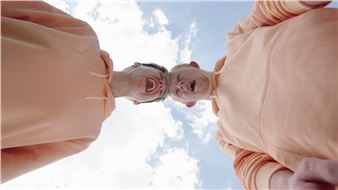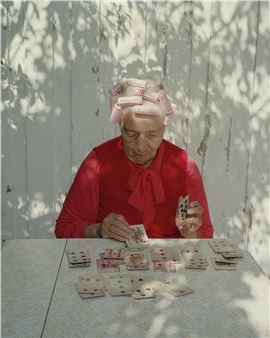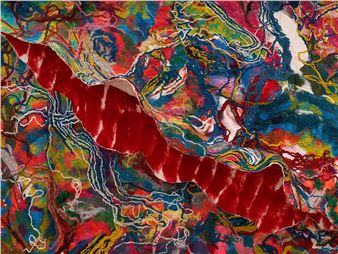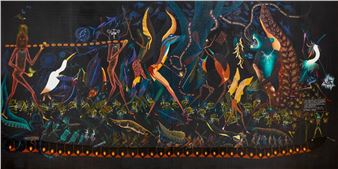Domestic Vernacular
The show is called вАЬDomestic VernacularвАЭ. I originally chose the word вАЬvernacularвАЭ for its use in describing an architectural style local to a specific geographic region. A type of folk-style building commonly referred too as вАЬEnglish VernacularвАЭ. Architecture acts as a kind of language, a psycho-geographical semiotic code encrypted into landscape, flaneurism and public space.
The vernacular is synonymous to colloquial. Folkloric, or art outside the public authorised realm, is usually restricted to the private home. The domestic is a fitting comparison - the realm of the woman, or child, it also sits outside of the monumental or governing sphere. It is here that we find the purest forms of expression, unbridled by ideology, expressions of вАЬsoft-powerвАЭ.
I began thinking about the domestic as a site of psychic visual expression. I wanted a show that conjured the feelings of both Dorothea TanningвАЩs Room 101 and Gregor SchneiderвАЩs Haus u r.. Both works are large-scale installations that play with the home, or the familiar, as a place (palace) of repression and architectonic fear. Any gendered connotation to вАЬDomesticвАЭ is largely coincidental: the domestic space, to me, is where our personal vernacular is most often felt, and while it is traditionally a matriarchal sphere, this is no way prescriptive.
Domestic Vernacular is a mixed-media show of painting, sculpture and photography that examines how visual language, both figurative and realistic, becomes a vernacular for artists. How images become common, quaint, and easily communicable but misunderstood or romanticised, from an outsider's perspective. Vernacular has emerged in art styles once again as a form of resistance against homogeny = the incorporation of difference as a method of suppression. This reflects the typological language of art theory as much as it pertains to style, taste and denominators of distaste: kitsch, vulgar, naff.
How do we project our internal selves onto our built surroundings, and how does this distort said structures? One medium is the вАЬretroвАЭ or vintage aesthetic, a vernacular that is now dated, which is reclaimed by artists in both figurative painting and installation work. This retroactive vernacular is transformed - it glitches and replicates, imitating the language of technocracy by morphing itself with established codes and structures. A domestic vernacular for the digital age.
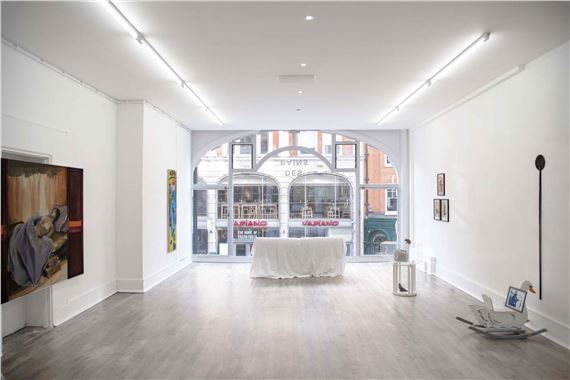
Recommended for you
The show is called вАЬDomestic VernacularвАЭ. I originally chose the word вАЬvernacularвАЭ for its use in describing an architectural style local to a specific geographic region. A type of folk-style building commonly referred too as вАЬEnglish VernacularвАЭ. Architecture acts as a kind of language, a psycho-geographical semiotic code encrypted into landscape, flaneurism and public space.
The vernacular is synonymous to colloquial. Folkloric, or art outside the public authorised realm, is usually restricted to the private home. The domestic is a fitting comparison - the realm of the woman, or child, it also sits outside of the monumental or governing sphere. It is here that we find the purest forms of expression, unbridled by ideology, expressions of вАЬsoft-powerвАЭ.
I began thinking about the domestic as a site of psychic visual expression. I wanted a show that conjured the feelings of both Dorothea TanningвАЩs Room 101 and Gregor SchneiderвАЩs Haus u r.. Both works are large-scale installations that play with the home, or the familiar, as a place (palace) of repression and architectonic fear. Any gendered connotation to вАЬDomesticвАЭ is largely coincidental: the domestic space, to me, is where our personal vernacular is most often felt, and while it is traditionally a matriarchal sphere, this is no way prescriptive.
Domestic Vernacular is a mixed-media show of painting, sculpture and photography that examines how visual language, both figurative and realistic, becomes a vernacular for artists. How images become common, quaint, and easily communicable but misunderstood or romanticised, from an outsider's perspective. Vernacular has emerged in art styles once again as a form of resistance against homogeny = the incorporation of difference as a method of suppression. This reflects the typological language of art theory as much as it pertains to style, taste and denominators of distaste: kitsch, vulgar, naff.
How do we project our internal selves onto our built surroundings, and how does this distort said structures? One medium is the вАЬretroвАЭ or vintage aesthetic, a vernacular that is now dated, which is reclaimed by artists in both figurative painting and installation work. This retroactive vernacular is transformed - it glitches and replicates, imitating the language of technocracy by morphing itself with established codes and structures. A domestic vernacular for the digital age.
Artists on show
Contact details


 ARTISTS
ARTISTS







